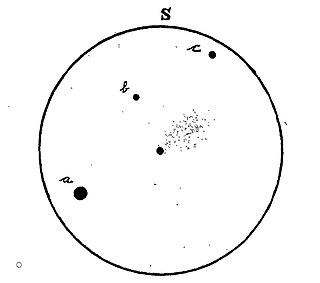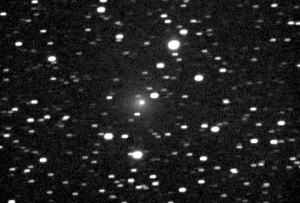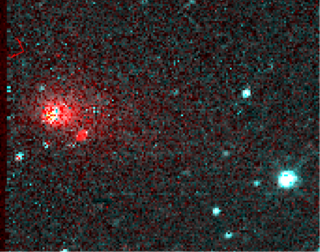
10P/Tempel, also known as Tempel 2, is a periodic Jupiter-family comet with a 5 year orbital period. It was discovered on July 4, 1873 by Wilhelm Tempel. The next perihelion passage is 2 August 2026 when the comet will have a solar elongation of 164 degrees at approximately apparent magnitude 8. Closest approach to Earth will be one day later on 3 August 2026 at a distance of 0.414 AU (61.9 million km).

28P/Neujmin, also known as Neujmin 1, is a large periodic comet in the Solar System. With a perihelion distance of 1.5AU, this comet does not make close approaches to the Earth.

52P/Harrington–Abell is a periodic comet in the Solar System.

60P/Tsuchinshan, also known as Tsuchinshan 2, is a periodic comet in the Solar System with an orbital period of 6.79 years. Tsuchinshan is the Wade-Giles transliteration corresponding to the pinyin Zĭjīn Shān, which is Mandarin Chinese for "Purple Mountain".

78P/Gehrels, also known as Gehrels 2, is a Jupiter-family periodic comet in the Solar System with a current orbital period of 7.22 years.

88P/Howell is a periodic comet with a 5.5 year orbital period. It was discovered on 29 August 1981, by Ellen Howell. In 1975 the comet's perihelion was 1.9 AU, but a close approach to Jupiter in 1978 perturbed the perihelion distance closer to the Sun. During the 2009 apparition the comet became as bright as apparent magnitude 8.
152P/Helin–Lawrence is a periodic comet in the Solar System.

13P/Olbers is a periodic comet with an orbital period of 69 years. It fits the classical definition of a Halley-type comet with. The comet had last been seen in 1956 and the next perihelion is on 30 June 2024.

Comet Finlay is a periodic comet with an orbital period of 6 years discovered by William Henry Finlay on September 26, 1886. The next perihelion passage is July 13, 2021 when the comet will have a solar elongation of 54 degrees at approximately apparent magnitude 10. It last came to perihelion on December 27, 2014, at around magnitude 10. Of the numbered periodic comets, the orbit of 15P/Finlay has one of the smallest minimum orbit intersection distances with the orbit of Earth (E-MOID). In October 2060 the comet will pass about 5 million km from Earth.
20D/Westphal was a periodic comet with an orbital period of 61 years. It fits the classical definition of a Halley-type comet. The comet appeared to disintergrate during the 1913 apparition and hasn't been observed since then.

Comet Kopff or 22P/Kopff is a periodic comet in the Solar System. Discovered on August 23, 1906, it was named after August Kopff who discovered the comet. The comet was missed on its November 1912 return, but was recovered on its June 1919 return and has been seen at every apparition since. Close approaches to Jupiter in 1938 and 1943 decreased the perihelion distance and orbital period. 22P/Kopff’s last perihelion passage was 18 March 2022. On 13 July 2028 it will pass 0.353 AU (52.8 million km) from Earth.

Comet Schaumasse is a periodic comet discovered by Alexandre Schaumasse on 1 December 1911 as 12th magnitude. It next comes to perihelion on 8 January 2026 and should brighten to about magnitude 9.
Comet Crommelin, also known as Comet Pons-Coggia-Winnecke-Forbes, is a periodic comet with an orbital period of almost 28 years. It fits the classical definition of a Halley-type comet with. It is named after the British astronomer Andrew C. D. Crommelin who calculated its orbit in 1930. It is one of only four comets not named after their discoverer(s), the other three being Comets Halley, Encke, and Lexell. It next comes to perihelion around May 27, 2039 when it will be near a maximum near-perihelion distance from Earth.

68P/Klemola or Klemola's Comet is a periodic comet, which belongs to Jupiter's comet family, that was discovered in 1965 by American astronomer Arnold Richard Klemola in Argentinian Yale-Columbia Southern Station. Its orbital period is 10.82 years.
82P/Gehrels is a periodic comet that was discovered on October 27, 1975, by Tom Gehrels at the Palomar Mountain Observatory in California having a faint nuclear brightness of magnitude 17.

62P/Tsuchinshan, also known as Tsuchinshan 1, is a periodic comet discovered on 1965 January 1 at Purple Mountain Observatory, Nanking. It will next come to perihelion on 25 December 2023 at around apparent magnitude 8, and will be 0.53 AU (79 million km) from Earth and 110 degrees from the Sun.
51P/Harrington is a periodic comet in the Solar System.

66P/du Toit is a periodic comet in the Solar System with a current orbital period of 14.78 years. It came to perihelion on 2018 May 19 at roughly apparent magnitude 12.
79P/du Toit–Hartley or du Toit 2 is a periodic comet, now divided into two parts, in the Solar System with an orbital period of 5.06 years. It next comes to perihelion in September 2023 but is only expected to reach about apparent magnitude 18. It will be less than 90 degrees from the Sun from February 2023 until June 2024. On 26 May 2024 it will be 2.7 AU from the Sun and Earth.

104P/Kowal, also known as Kowal 2, is a periodic Jupiter-family comet discovered by Charles T. Kowal in 1979. The orbit was confirmed after new sightings in 1991 and 1998.
















